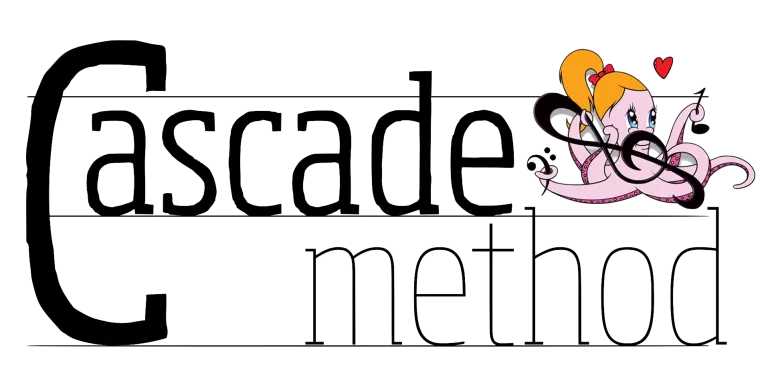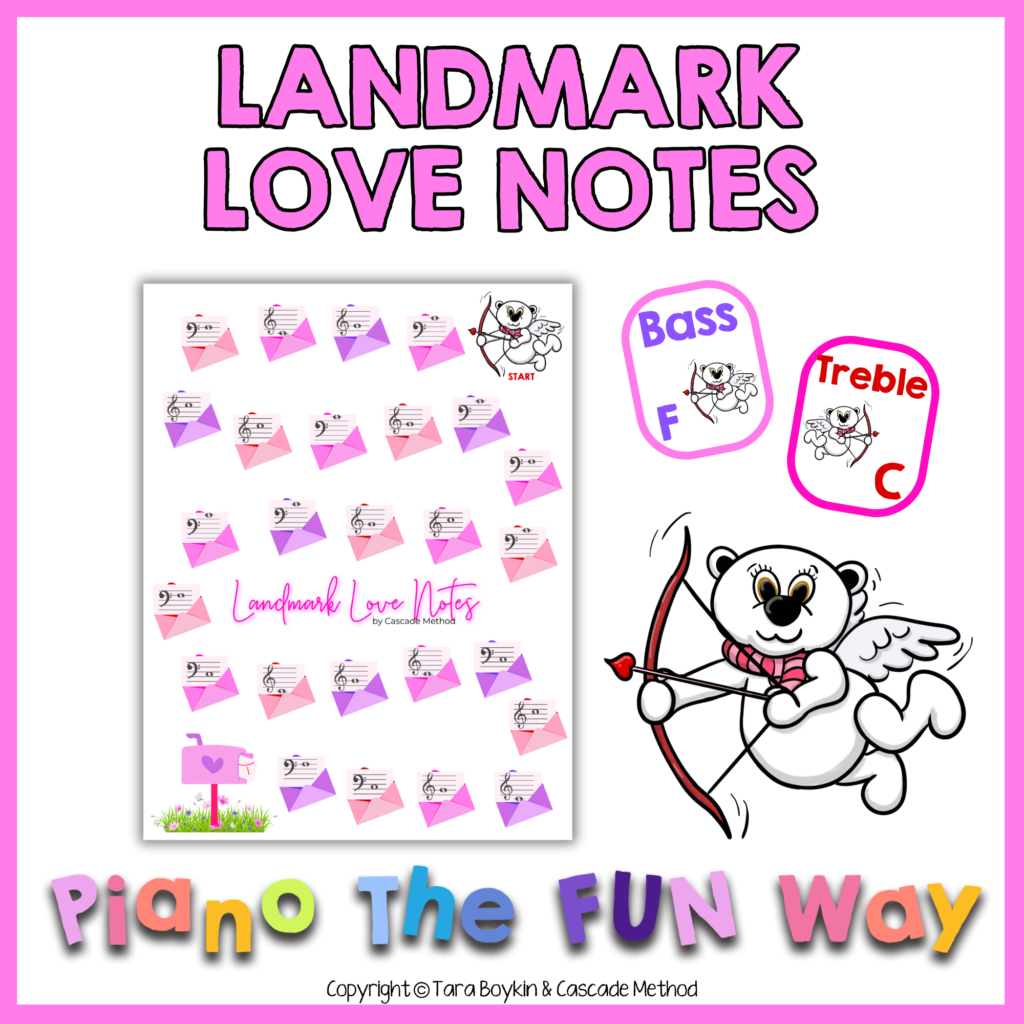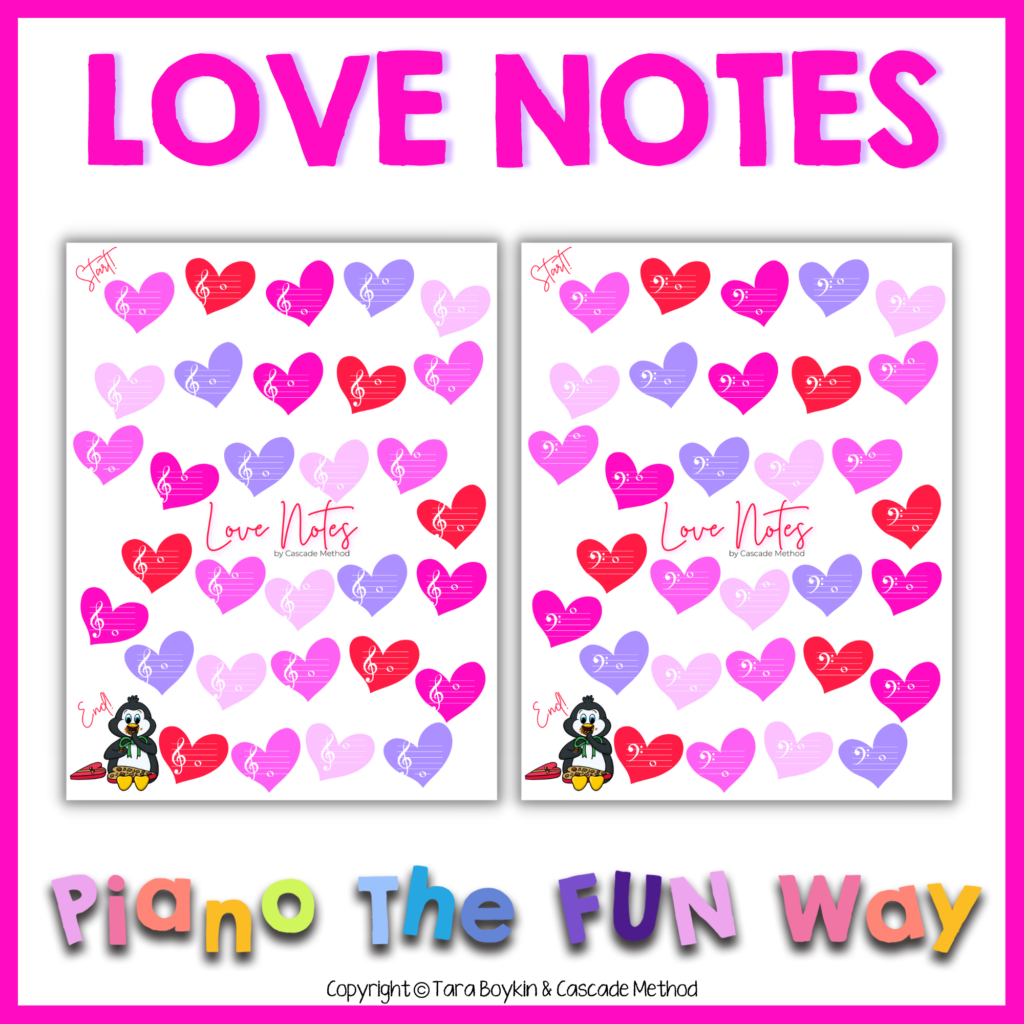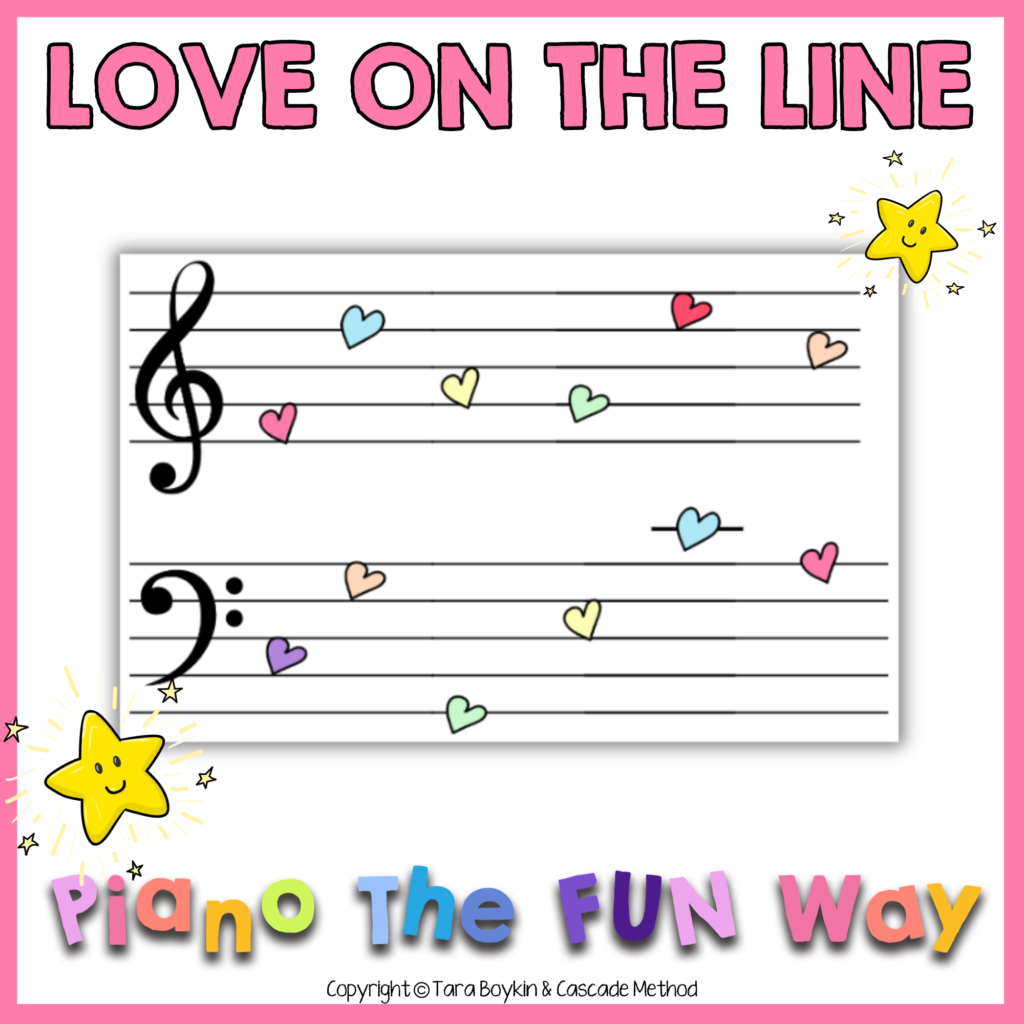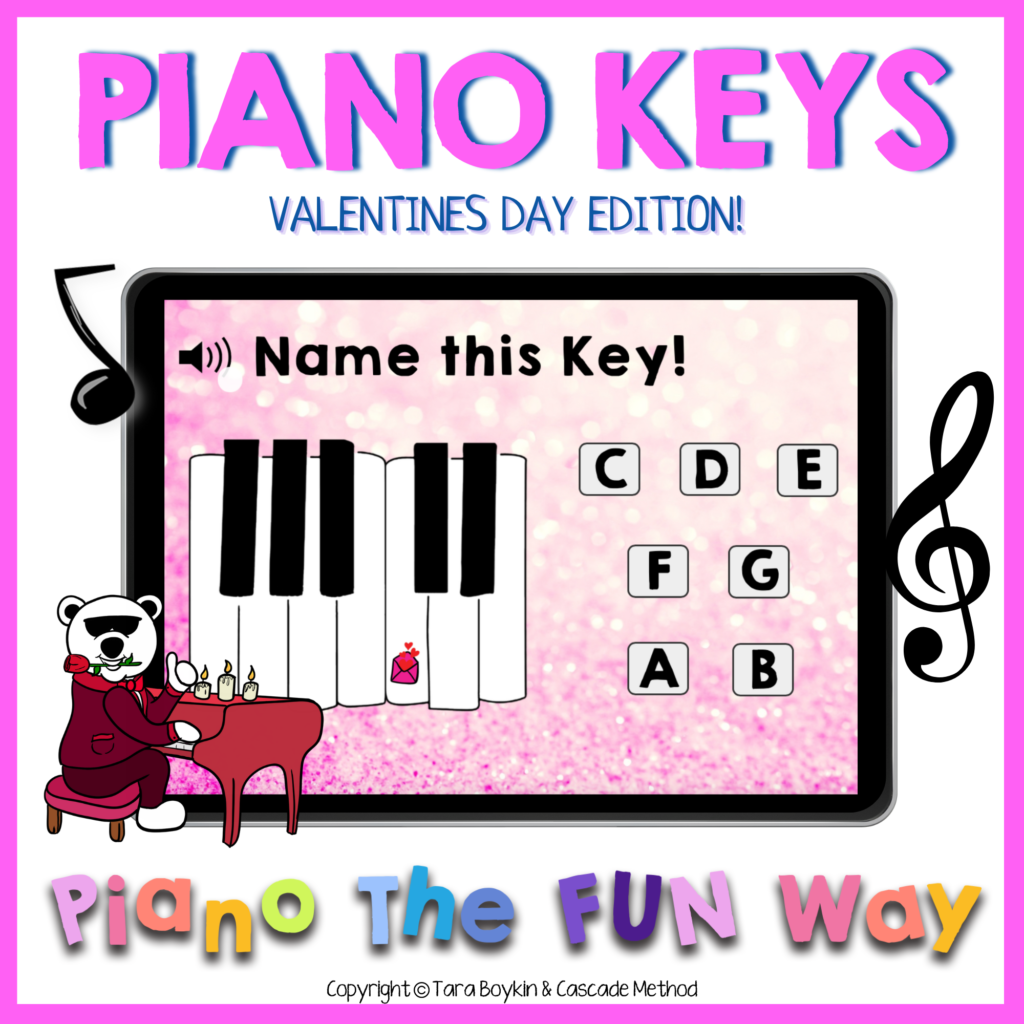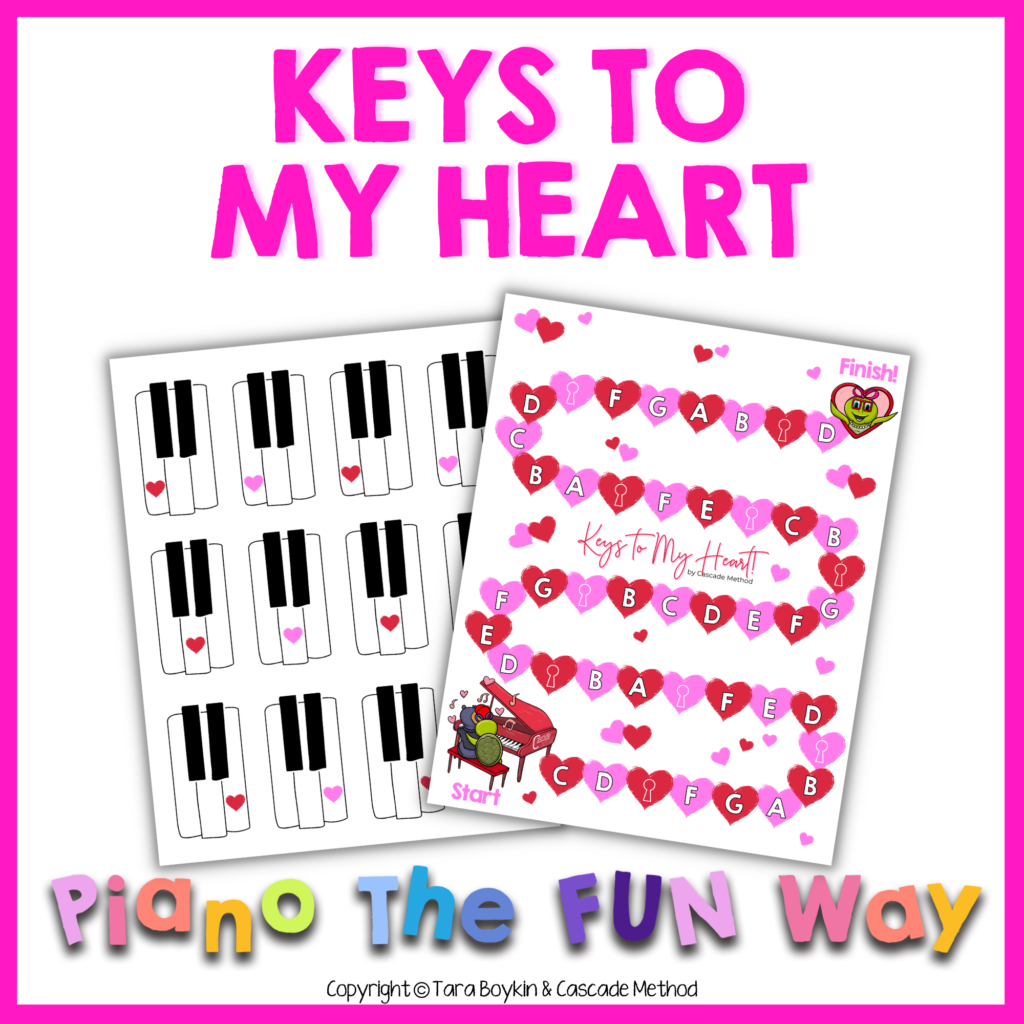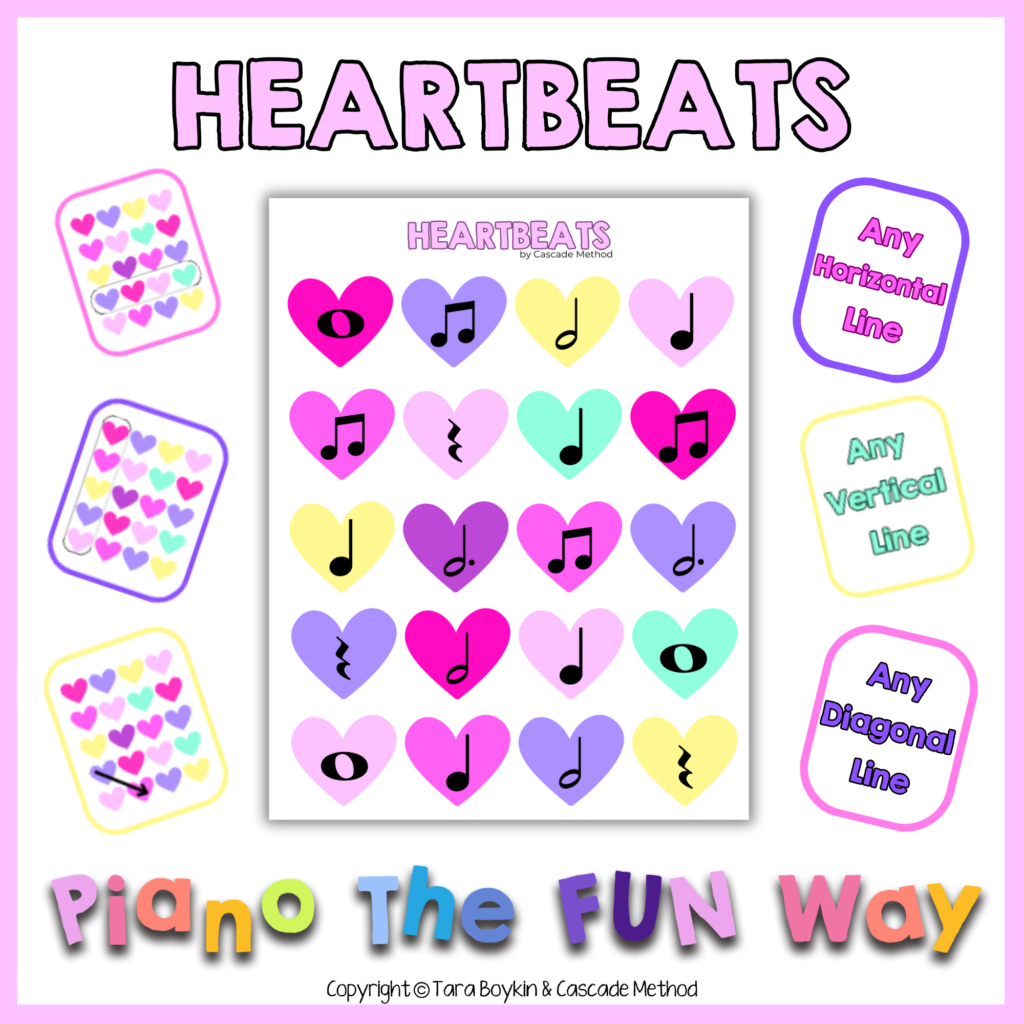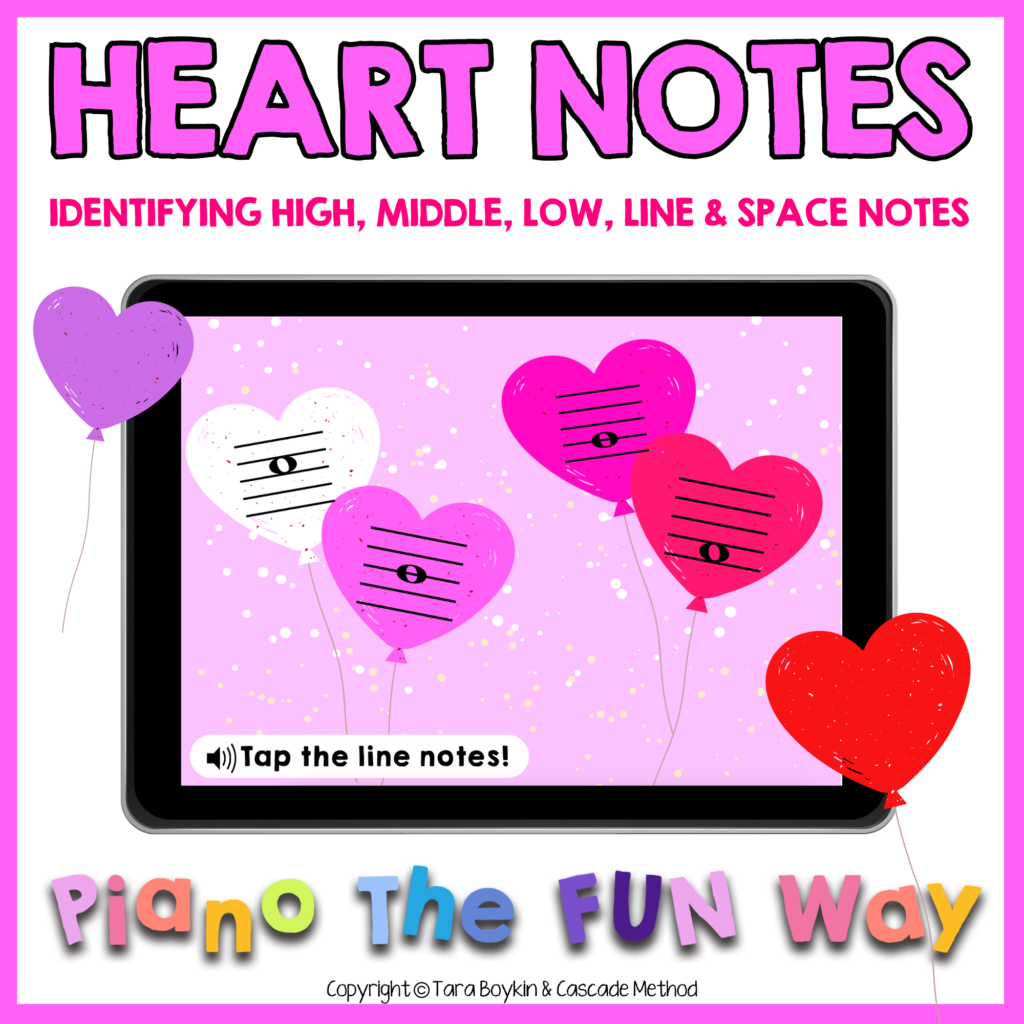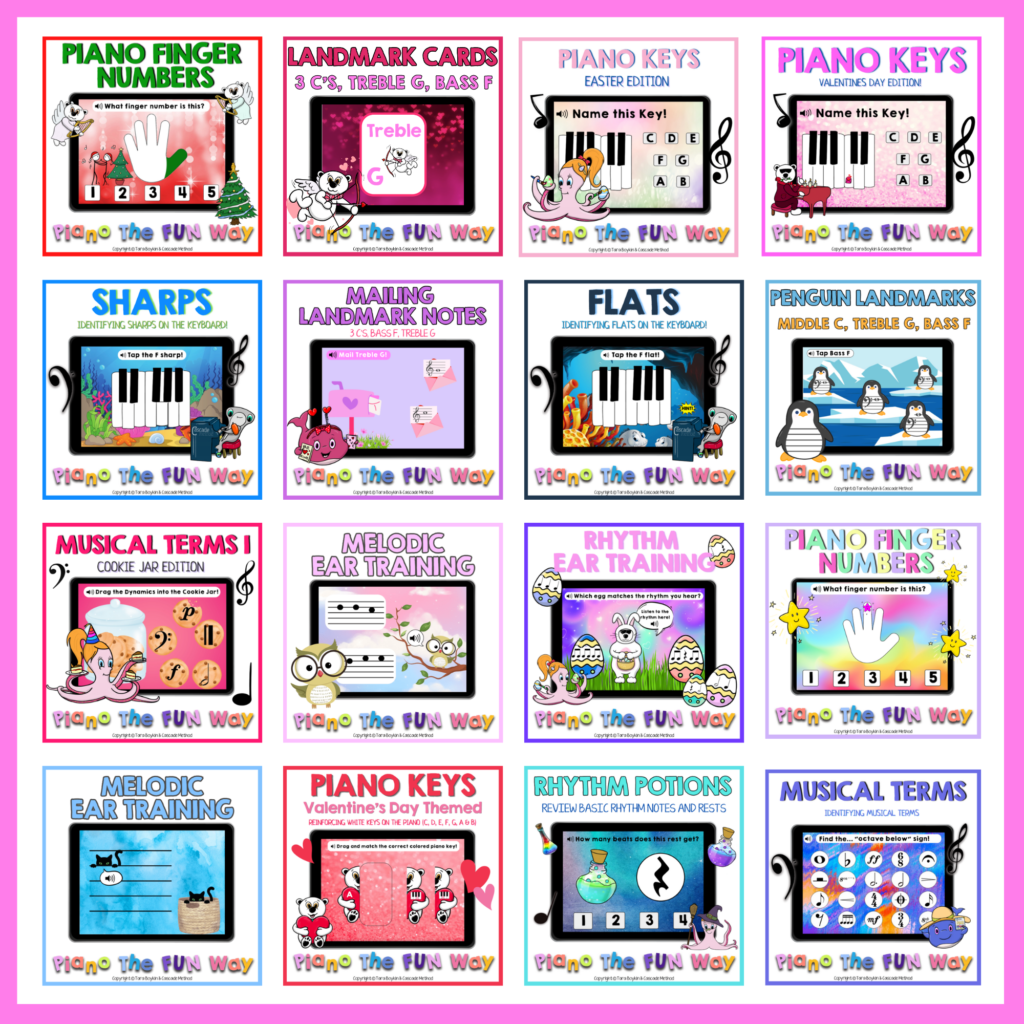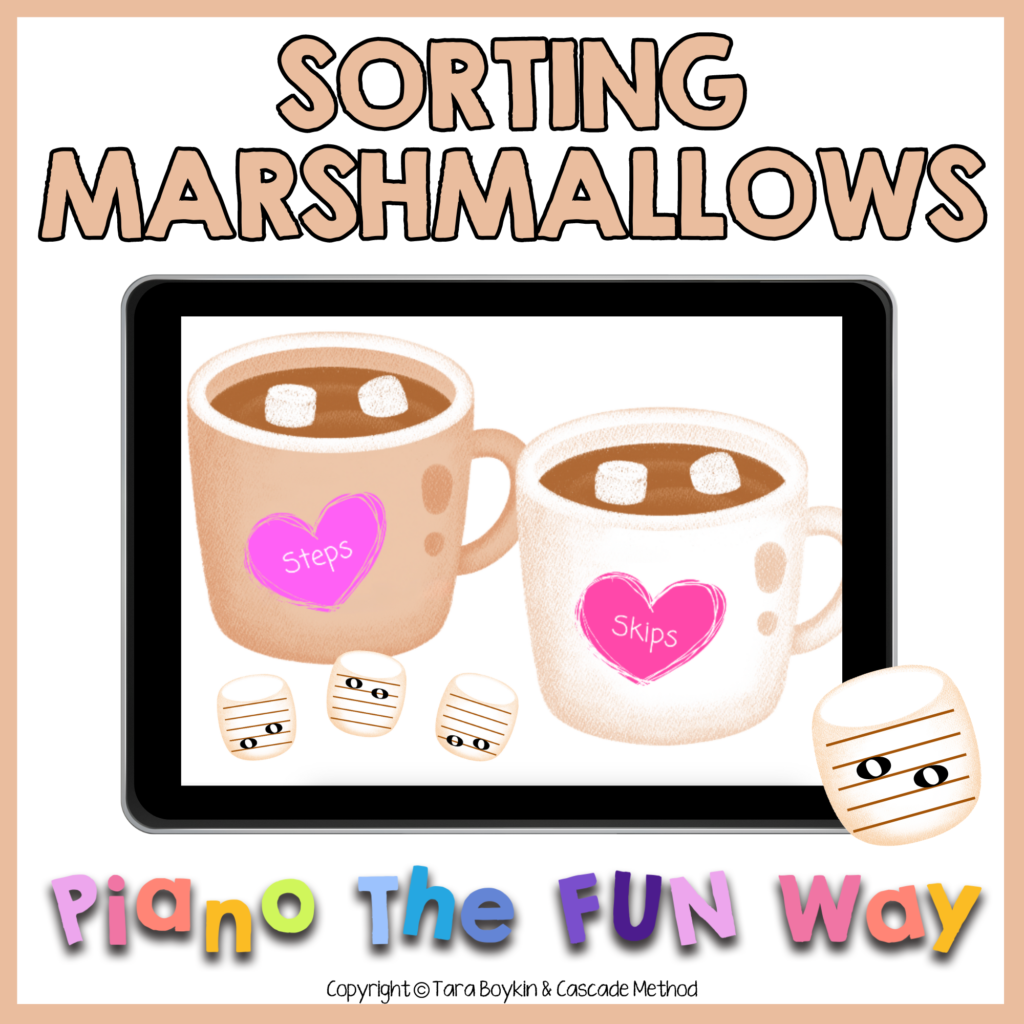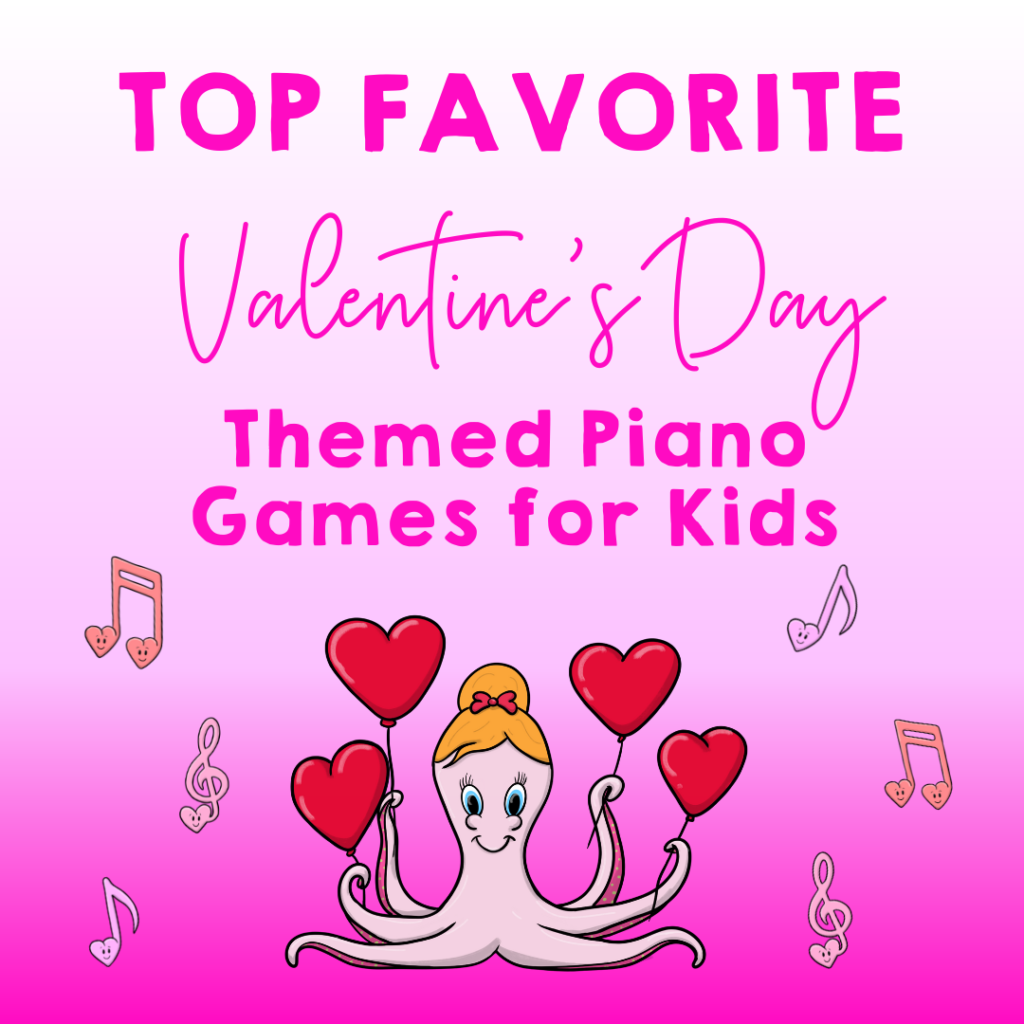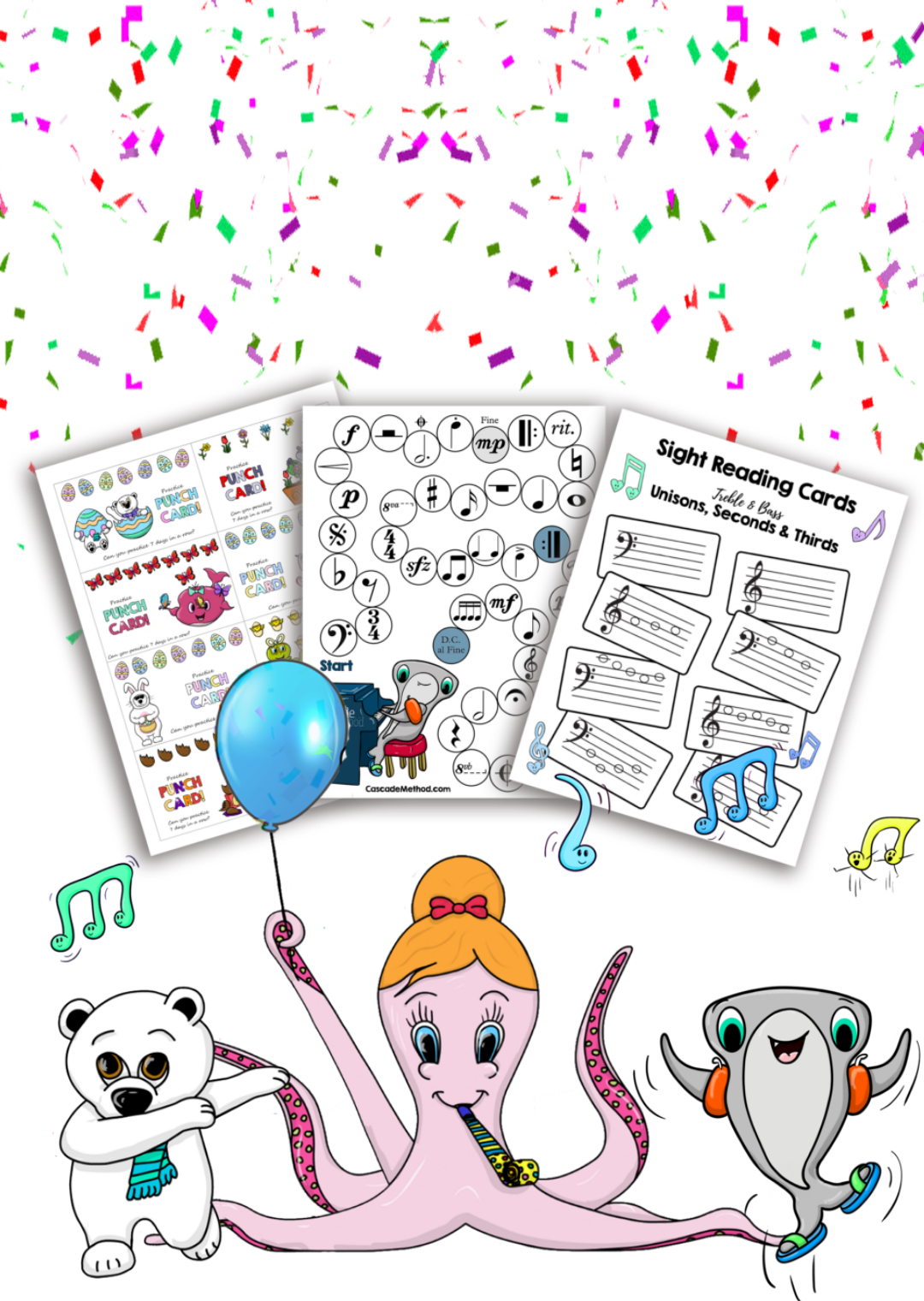
Top Favorite Valentine’s Day Themed Piano Games for Kids (Part 2)
As if one blog wasn’t enough for all my favorite Valentine’s games, here’s are seven freshly baked cookies – I mean, piano games!
I LOVE the month of February because that means I can bring out EVERY single pink game I own 😂💕 If you haven’t noticed from my brand, I’m only low-key obsessed with pink 😝
Below, I’ll be sharing both physical and printable piano games I’ve created, as well as digital boom cards. Being a mom of two young children means that LOW-PREP is key around here! So I’m always finding ways that I can combine physical games, and boom cards, for the least amount of prep possible (for YOU!)
Get ready for the best overload of Valentines-themed piano games!
This fun Valentine-Themed printable piano game will help your students reinforce their landmarks! Landmarks included in this game are all the C’s (middle, Bass and treble), as well as Treble G and Bass F!
Here’s how to play:
- Shuffle the playing cards and place them face down (*see low prep option)
- Student pulls a card and moves to the correct spot.
- First player to reach the mailbox wins.
I am ALL about using games in multiple ways, so I’ve included a ton of alternate options for you and your students. These are different ways you can play with the playing cards that I’ve included inside!
- Shuffle the playing cards, and place them face down in a pile.
- Students pull a card and play the note in question, on the piano. For example, if they pull “Bass C,” they have to play bass C on the piano.
- Taking it a step further, if you have a printed grand staff, student will place a pawn in the correct space. For example, if they pull “Middle C,” they have to play the pawn on the middle C location on the staff.
- Taking it a step even further, instead of placing a pawn, students will draw the note in question. I personally always have a laminated grand staff on hand (with a magnetic sheet behind it), so I can either have kids draw on it with a white board marker, or play with round magnets that act as “notes.” The possibilities are endless with that grand staff, and so adaptable to piano games!
- You can also play with a dice. Roll the dice and student moves to the correct spot. Student will name the note they land on.
If you know me, you know that I am ALL about low-prep! I’m also a huge fan of being able to use a game in a gazillion ways, and this is just one of them!
This fun Valentine-Themed landmark game can be used alone, to reinforce all the C’s on the staff (bass, middle, and treble), treble G, and Bass F. However, the original reason I created this boom deck was so that piano teachers like you, who don’t have a ton of extra time, wouldn’t have to print, laminate, and cut up all these playing cards!
Another huge bonus about using these landmark cards is that you can actually play the game you see above, even with your online students! That’s right! You can send the printable game to your piano families, and then use these cards over zoom, and they can have their own “playing cards!” Seriously, it’s a win-win for everyone! The best part, students can actually play the game above, at home, during their week away from you!
Another cool feature about this deck is that if you’re having students just find these notes on the piano, or wanting them to write the notes out on the staff, the card is movable and the “answer” is behind! So if they want to check their answer, it’s there!
- Name the type of note: If it’s a line or space
- Say if the note is high or low on the staff
- Name the actual note
- Name and play the note on the piano
- More advanced: whatever number was on the dice, student plays that interval off the note (above or below). Example: If they rolled a 3, student will play a 3rd up or down from the note they land on.
- First player to land on Penni the Penguin wins!
- Practice finding lines and spaces: Say “I spy,” or “find” a space note (students will place an eraser/pawn on any space note). You can be more specific, “I spy a space note in the treble clef”, or “…bass clef,” or “I spy a space note in the 3rd space” (could be either treble or bass). If you’re playing this as a group, the student who fills up their entire board first wins. Each board has a different set of notes.
- Review line numbers and space numbers. For example, “find notes on line 1” or “space 3”
- Review high and low notes: Ask students to place an eraser on a “high” or “low note” (could be any clef, or you could be more specific and name a clef).
- Review notes: Have students write in all the notes with a dry erase marker (if you didn’t laminate, you can put it in a pouch and have kids write on that as well)
- Practice intervals: From unisons, to steps, skips and more, have students place an erase, or draw a note for the desired interval. For example, tell students to draw a step up from every note on the board. Or, place an erase a skip down from all the space notes… Or draw a skip up from all the line notes in the treble clef…
Piano Keys (Valentine-Themed)
This Digital Valentine’s Day Themed Boom Card deck is perfect for piano beginners who are still learning the names of the white keys on the piano (I.e. C, D, E, F, G, A & B). Students will just have to name the correct piano key!
This is such a versatile game too! It can be used as simply with your beginner students who are just learning their piano keys, to more advanced students learning chords, and scales!!
Here are all the variations you can do with this game:
With the playing cards:
- (Easy) Put the cards face down in a pile. Each player takes a turn and picks up a card. Student moves to the space that corresponds to the heart. For example, if a student picks up a card where the heart is on a D, they’ll move to a D on the board.
- If a student picks up one of the cards that says “Go back ONE space,” or “Draw another card,” students will follow the directions on that card.
- If a student lands on a key hole, they can move to the next keyhole on the board.
- First student to gets a note past the last “D” at the end, wins!
2) With a dice and ONLY the board game:
- (Easy) Roll the dice, and move to the correct space. Play the corresponding note on the piano. Example: If you land on a G, student will play a G on the piano. If a student lands on a key hole, they can move to the next keyhole on the board.
- (Medium, Composition Emphasis) Roll the dice, and move to the correct space. Student will draw / write out the note they landed on (either on a white board grand staff, or on a paper staff). Example, if they land on a C, they can draw a middle C, a treble C or bass C (depending on their level and the notes they’ve learned).
- (Harder, emphasis on other theory concepts) Decide at the beginning if the notes on the board correspond to major or minor concepts (scales, chords, chord progressions, inversions, or other concepts you can think of). Roll the dice, and move to the correct space. Student will play the corresponding concept you decided at the beginning of the game.
- For example, if you’re working on major scales, if a student lands on C, they’ll play a C major scale for you on the piano (or name the key signature… so many options!) If you’re working on chords and a student lands on F, they’ll play an F major chord on the piano. You can even decide that they’ll play both the major and minor version of the F chord…
This Rhythm Valentine’s Themed game is perfect to review rhythm! Once you download the board, there are tons of little cards that come with it. Depending on what’s circled, or which way the arrows are pointing, students will have to clap or count that line out loud! If you have total beginners, you can also have them place little pawns on the rhythm you call. There’s always ways you can adapt these games for your piano students!
Here are all the ways you can play:
- Shuffle the playing cards and place them face down.
- Student pulls a card and claps out the rhythm they see on the card.
- They may pull a card that circles the hearts to clap out. When they’re circled, they can play in any direction they want (left to right, or right to left).
- Some cards have arrows with a specific direction (so students will clap out the rhythm in that order).
- Some cards just say to play “any vertical, horizontal, or diagonal line.” Just follow the directions of those cards.
- Some cards say “Find and clap hearts in 3/4” (or 4/4). This means students must find hearts that are next to one another, that add up to 3 beats, or 4 beats total.
- For example:
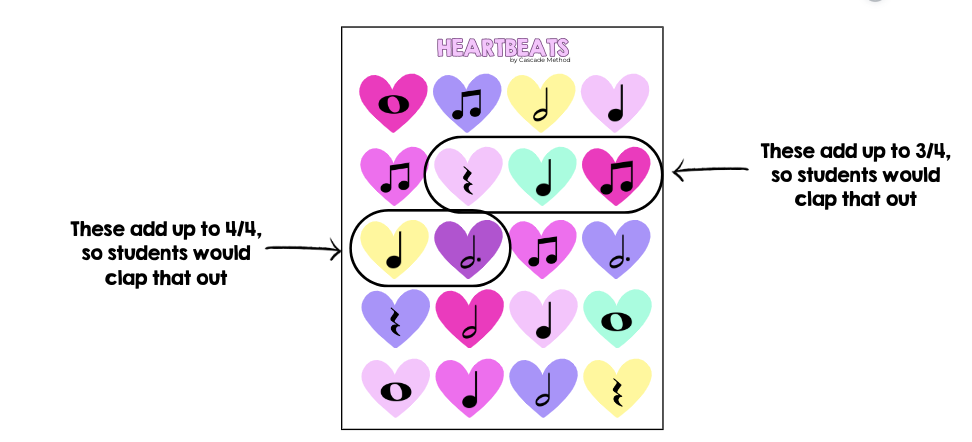
- You decide how long you want to play (from a couple cards, to all the cards).
- If you have competitive students, you can have them keep the cards that they “clap” correctly. Whoever has the most cards by the end, wins.
- For students just learning the names of the types of notes and rests, you can have them place little pawns on the type of rhythm you call. For example, call out a quarter note, and they have to place a pawn on ONE, or all quarter notes. Do the same for the half note, dotted half note, whole note, quarter rest, and eighth notes.
This cute Valentine’s Themed deck will help students reinforce the location of notes on the staff (there are no clefs included). Students will have to identify if the notes are high, low, in the middle, on a line, or in a space!
This is the perfect beginner game for kids during February!
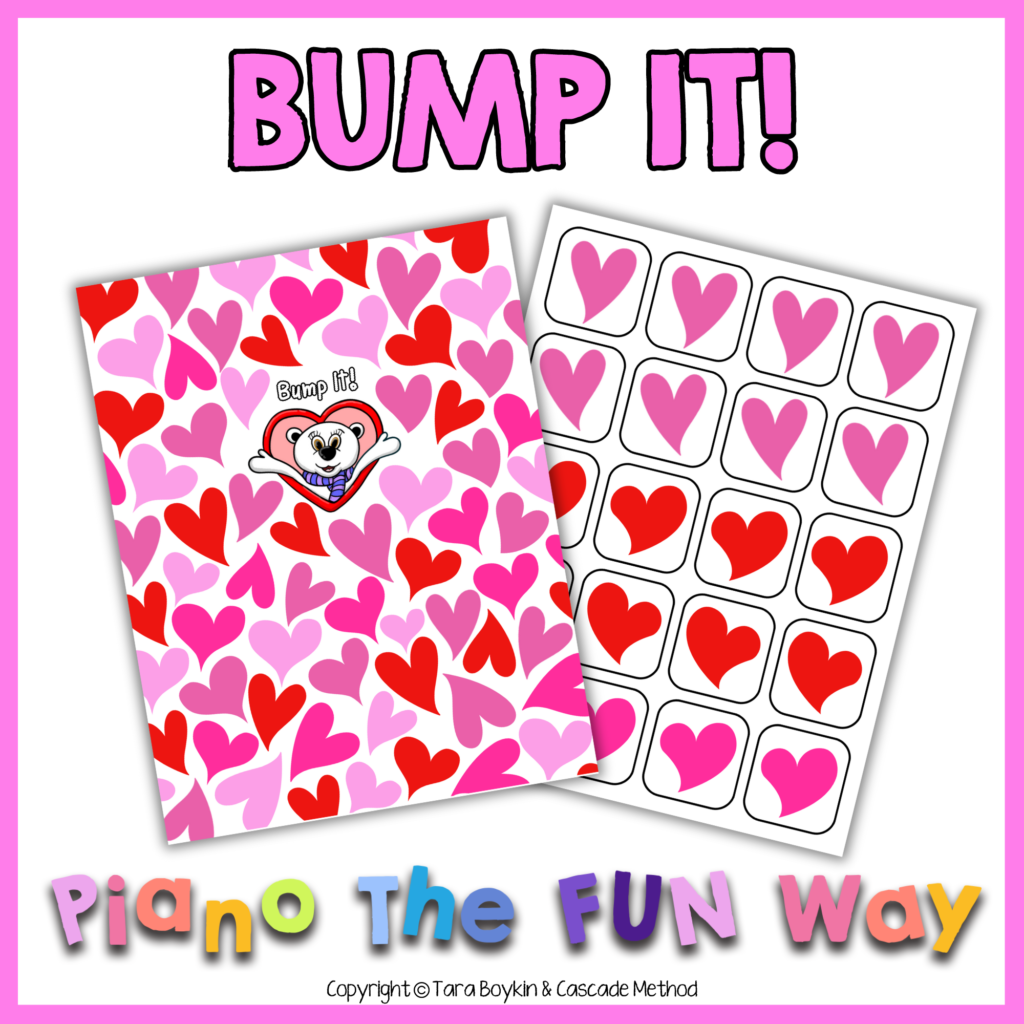
This is one of the most versatile games! And don’t be fooled by the fact that you don’t see anything musical … that’s because this printable piano game allows you to reinforce DOZENS of concepts!!!
Before I explain how to use this game I have an …
IMPORTANT NOTE:
- Depending on the concept you want to teach, or work on, you will need an additional set of cards to work with. For example, if you want to reinforce rhythm, you will need a set of rhythm cards. If you’re working on finger numbers, use a deck of finger number cards… same for chords, intervals, notes on the staff… But the possibilities are endless!
How to play:
- Students place 5-10 pawns/game pieces on different hearts on the board (the more pawns, the longer the game).
- Shuffle the “heart playing cards” and place them face down
- Use the “other cards” (depending on the concept you’re teaching). (*see low prep option)
- Student pulls a card from the “concept” you’re trying to teach. Let’s use rhythm cards as an example. Student pull a half note. If they name it correctly, they get to pull a “heart” card and “bump” off another player’s pawn. BUT! Students can only bump off another player’s pawn that matches the color of the heart drawn. For example, if they pull a red heart, they can only bump off the other player’s pawn that’s on a red heart.
- Last player on the board to have a pawn wins!
- If you don’t have extra playing cards on hand that reinforce all the concepts mentioned before, you can always purchase boom cards and use these as your concept cards. Here are a few for inspiration!
This cute Valentine’s-themed deck will have your students sorting marshmallows into the correct hot chocolate cup! Marshmallows have either steps or skips on them, so students have to sort them correctly.
There are anywhere between 3 to 6 marshmallows to sort. This is a great game for beginners and even pre-readers! There are no clefs, so it’s all about identifying the distance between notes, and steps and skips are a great place to start!
Want ALL of these!?!
I've packaged ALL my Valentine's Games into a bundle!
I appreciate YOU and am grateful for all the support! If you use any of these games, I would love to hear from you! And please feel free to tag me on Instagram with any photos you share! I’d LOVE to see them!
Happy happy Valentine’s Day to you!
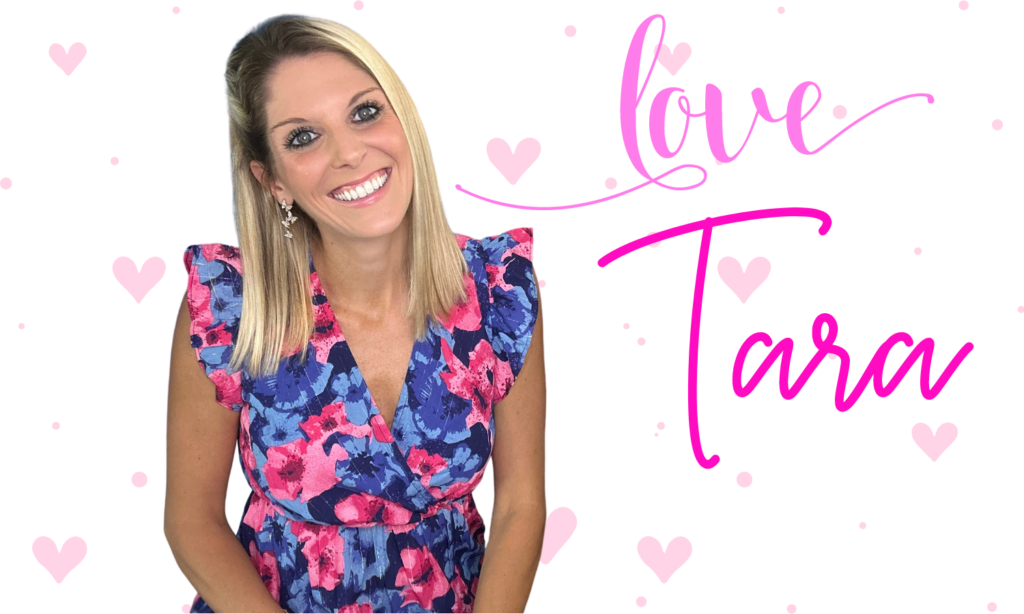
PS: Find 10+ games on my first Valentine’s Piano Game blog!
